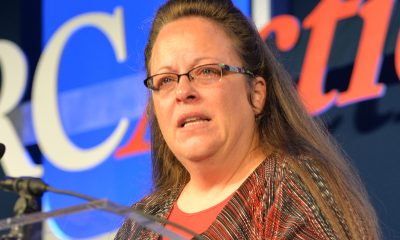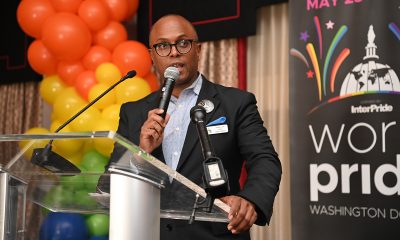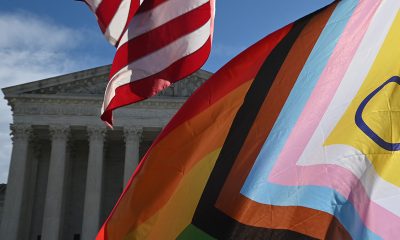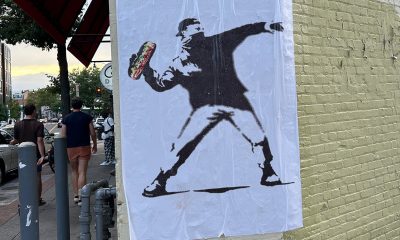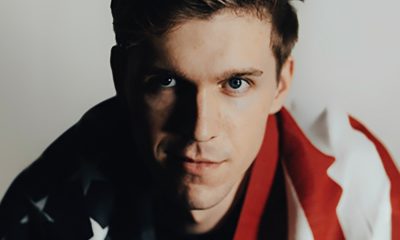Local
Mayoral candidates march in Pride Parade
Pro-LGBT rivals highlight tough choice for activists in race
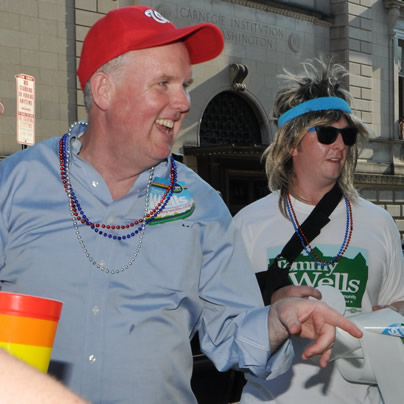
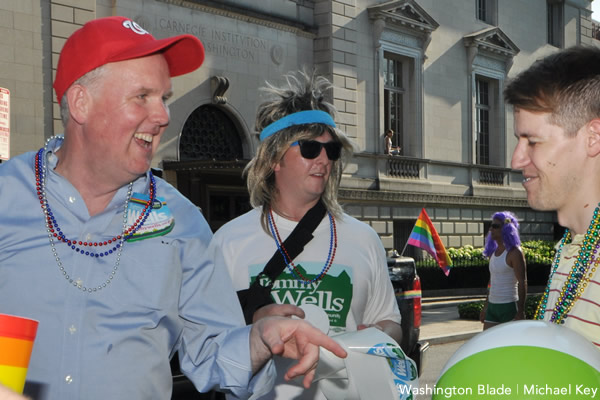
D.C. Council members Muriel Bowser (D-Ward 4), Tommy Wells (D-Ward 6) (on left), and Jack Evans (D-Ward 2) all marched in Saturday’s Pride parade. (Washington Blade photo by Michael Key)
D.C. Council members Muriel Bowser (D-Ward 4), Tommy Wells (D-Ward 6), and Jack Evans (D-Ward 2) – each of whom is running for mayor – waved to thousands of cheering onlookers on Saturday as they marched in D.C.’s Capital Pride Parade.
Mayor Vincent Gray, who has yet to announce whether he will run for a second term but who many believe will throw his hat in the ring, also marched in the parade, with LGBT supporters and city employees marching in his contingent.
The fact that four prominent politicians and long-time LGBT allies are either running or expected to run for mayor in the April 2014 Democratic mayoral primary highlights what many activists say is D.C.’s status as one of America’s most LGBT supportive cities.
But for many in the LGBT community, the fact that four longtime friends are running or likely to run against each other poses a dilemma. On what basis will they choose one over the other, some are asking.
In interviews with the Washington Blade during LGBT Pride month, several activists who discussed the upcoming mayoral election said it is far too early to make a decision on whom to back, even among those who supported Gray in his 2010 mayoral election campaign.
“We don’t know who else will get in the race,” said gay Democratic activist Peter Rosenstein, who supported Gray in 2010 and who has written several commentaries for the Blade praising Gray’s administration for making important improvements in the city, including the local economy.
“It’s much too early to make a decision,” Rosenstein said.
Veteran gay and AIDS activist Cornelius Baker, however, said he remains a strong Gray supporter and he and many others in the LGBT community he knows won’t line up behind anyone else until Gray makes his intentions known.
“We’re all waiting for him to give us the word that he’s running,” said Baker at a Black LGBT Pride event two weeks ago. “I’m ready to do all I can to support him because he’s done an excellent job on the issues that are important to me.”
Rick Rosendall, president of the Gay and Lesbian Activists Alliance, a non-partisan advocacy group that rates candidates based on their record and positions on LGBT-related issues, expressed caution about basing a decision on who to back solely on a candidate’s general statements of support.
“All friends are not created equal,” he said. “It behooves us to look inside the wrappers and compare the candidates’ records on translating their friendly words into results,” said Rosendall. “But that’s for another day – it’s Pride, and we have much to celebrate.”
Rosendall backed Gray in the 2010 election.
Christopher Dyer, who served as director of the city’s Office of GLBT Affairs under Mayor Adrian Fenty, said he’s supporting Bowser, who was a strong Fenty supporter in the 2010 election in which Gray beat Fenty in a hotly contested race.
Also backing Bowser is gay activist and businessman Everett Hamilton.
If Fenty’s LGBT backers transfer their support to Bowser, who was a strong political ally of Fenty’s, the Ward 4 Council woman could receive a considerable boost for her campaign among LGBT voters. Fenty won in most of the city’s election precincts with high concentrations of LGBT residents in his unsuccessful bid for a second term in 2010.
Gay Democratic activist John Fanning said he is among the Ward 2 LGBT residents supporting Evans in the mayoral election next year.
“Jack has the experience and has paid his dues,” said Fanning, noting that Evans has been on the D.C. Council since 1991.
Mark Lee, an advocate for nightlife businesses and a business columnist for the Blade, said the mayoral contenders’ strong record of support on LGBT issues opens the way for LGBT voters to look at other issues.
“The hard work by community leaders over many years has made LGBT issues non-controversial in District politics or governance,” Lee said. “As a result, we now have both the opportunity and obligation to participate as full citizens and evaluate candidates on a wide range of issues.”
In media interviews during the past few weeks, each of the three Council contenders in the mayor’s race as well as Gray have said they welcome voter scrutiny of their positions and records on all issues.
Meanwhile, at least two others have given hints that they were considering entering the race. Gay D.C. Council member David Catania (I-At-Large) reportedly is weighing a run, according to political insiders. Should he run and win, Catania would make history by becoming the first out gay person elected mayor of D.C.
Robert C. Bobb, who served as city administrator under former D.C. Mayor Anthony Williams and later as president of the D.C. school board, is also said to be considering a run for mayor next year. Bobb expressed support for LGBT rights during his campaign for the school board post in 2006 as well as during his tenure as city administrator.
Catania, a longtime vocal supporter of LGBT rights, was the author and lead advocate for the city’s same-sex marriage law, which the D.C. Council passed in 2009. He recently switched from serving as chair of the Council’s Committee on Health to being chair of the Committee on Education, where he has emerged as a vocal advocate for school reform.
Evans, Bowser and Wells each voted for the marriage equality law after advocating for such legislation since winning election to the Council.
“I intend to spend more time focused on that, and when and if I decide to do something else I’ll make that decision, but it’s hard to do two tracks,” Catania told the Blade while marching in the Capital Pride Parade on Saturday. “People often make calculations that are not thoughtful and I want to postpone that campaign mode as long as possible,” he said.
Michael K. Lavers contributed to this report.
District of Columbia
Capital Pride files anti-stalking complaint against local LGBTQ activist
Darren Pasha denies charge, claims action is linked to Ashley Smith’s resignation
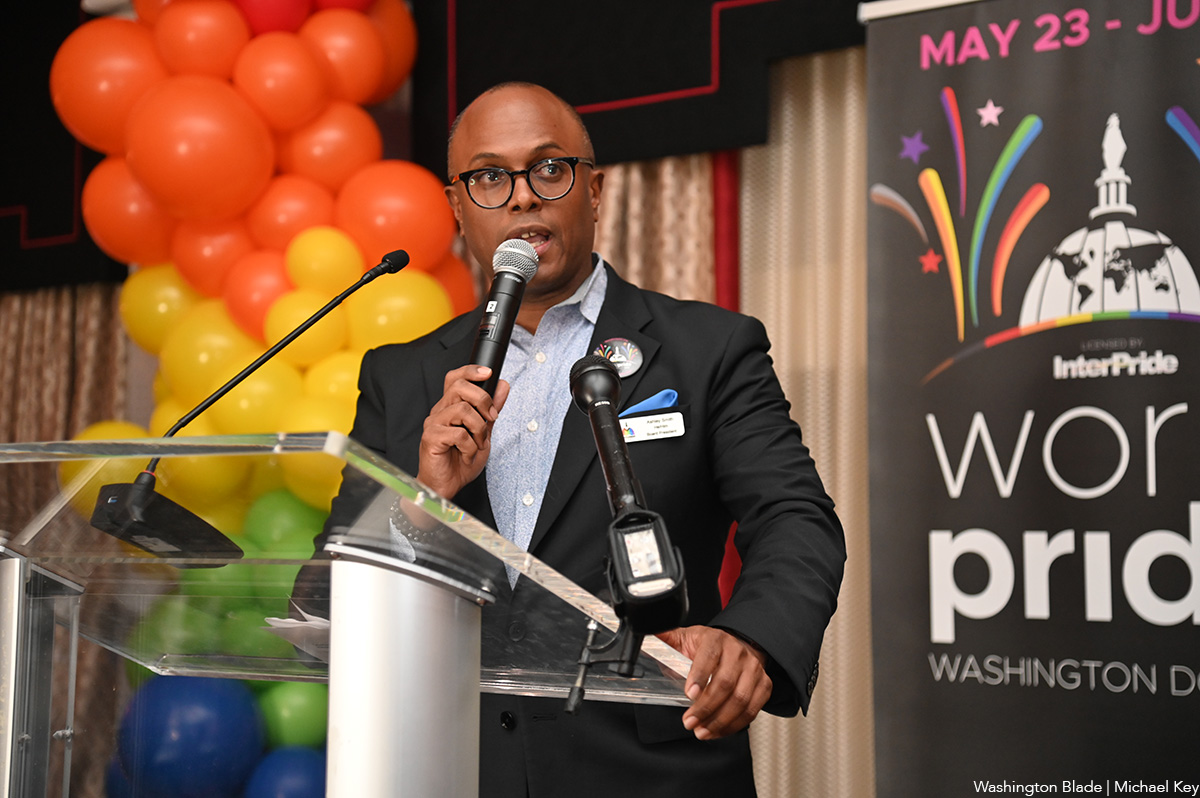
Capital Pride Alliance, the D.C.-based LGBTQ group that organizes the city’s annual Pride events, filed a Civil Complaint on Oct. 27 against local LGBTQ activist and former volunteer Darren Pasha, accusing him of engaging in a year-long effort to harass, intimidate, and stalk Capital Pride’s staff, board members, and volunteers.
The complaint, which was filed in D.C. Superior Court, was accompanied by a separate motion seeking a court restraining order, preliminary injunction and anti-stalking order prohibiting Pasha from “any further contact, harassment, intimidation, or interference with the Plaintiff, its staff, board members, volunteers, and affiliates.”
According to online court records, on Oct. 28, a judge issued an “initial order” setting the date for a scheduling conference for the case on Feb. 6, 2026. As of the end of the business day on Friday, Nov. 7, the judge did not issue a ruling on Capital Pride’s request for an injunction and restraining order
The court records show that on Nov. 5 Pasha filed an answer to the complaint in which he denies all allegations that he targeted Capital Pride officials or volunteers for stalking or that he engaged in any other improper behavior.
“It is evident that the document is replete with false, misleading, and unsubstantiated assertions,” Pasha says in his response, adding that “no credible or admissible evidence has been provided” to meet the statutory requirements for an anti-stalking order.
The Capital Pride complaint includes an 18-page legal brief outlining its allegations against Pasha and an additional 167-page addendum of “supporting exhibits” that includes multiple statements by witnesses whose names are blacked out in the court filing documents.
“Over the past year, Defendant Darren Dolshad Pasha (“DSP”} has engaged in a sustained and escalating course of conduct directed at CPA, including repeated and unwanted contact, harassment, intimidation, threats, manipulation, and coercive behavior targeting CPA staff, board members, volunteers, and affiliates,” the Capital Pride complaint states.
It continues, “This conduct included physical intimidation, unwanted physical contact, deception to gain unauthorized access to events, retaliatory threats, abusive digital communication, proxy-based harassment, and knowing defiance of organizational bans and protective orders.”
The sweeping anti-stalking order requested in Capital Pride’s court motion would prohibit Pasha from interacting in person or online or electronically with “all current and future staff, board members, and volunteers of Capital Pride Alliance, Inc.”
The proposed order adds, the “defendant shall stay at least 200 yards away from the principal offices of Capital Pride Alliance” and “shall stay at least 200 yards away from all Capital Pride Alliance events, event venues, associated activities, and affiliated gatherings.”
The reason for these restrictions, according to the complaint, is that Pasha’s actions toward Capital Pride staff, board members, and volunteers allegedly reached the level of causing them to fear for their safety, become “alarmed, disturbed, or frightened,” or suffer emotional distress as defined in D.C.’s anti-stalking law.
Among the Capital Pride officials who are identified by name and who have included statements in the complaint in support of its allegations against Pasha are Ashley Smith, the former Capital Pride Alliance board president, and June Crenshaw, the Capital Pride Alliance deputy director.
“I am making this declaration based on my personal knowledge to support CPA’s petition for a Civil Anti-Stalking Order (ASO) against Daren Pasha,” Smith says in his court statement. “My concerns about the respondent are based on my personal interactions with him as well as reports I have received from other members of the CPA community,” Smith states.
The Capital Pride complaint against Pasha and its supporting documents were filed by D.C. attorney Nick Harrison of the local law firm Harrison-Stein PC.
In his 16-page response to the complaint that he says he wrote himself without the aid of an attorney, Pasha says the Capital Pride complaint against him appears to be a form of retaliation against him for a dispute he has had with the organization and its then president, Ashley Smith, over the past year.
His response states that the announcement last month by Capital Pride that Smith resigned from his position as board president on Oct. 18 after it became aware of a “claim” regarding Smith and it had opened an investigation into the claim supports his assertion that Smith’s resignation is linked to his year-long claim that Smith tarnished his reputation.
Among his allegations against Smith in his response to the Capital Pride complaint, Pasha accuses Smith of using his position as a member of the board of the Human Rights Campaign, the D.C.-based national LGBTQ advocacy organization, to persuade HRC to terminate his position as an HRC volunteer and to ban him from attending any future HRC events. He attributes HRC’s action against him to “defamatory” claims about him by Smith related to his ongoing dispute with Smith.
The Capital Pride complaint cites HRC officials as saying Pasha was ousted from his role as a volunteer after he allegedly engaged in abusive and inappropriate behavior toward HRC staff members and other volunteers.
Capital Pride has so far declined to disclose the reason for Smith’s resignation pending an internal investigation.
In its statement announcing Smith’s resignation, a copy of which it sent to the Washington Blade, Capital Pride Alliance says, “Recently, CPA was made aware of a claim made regarding him. The organization has retained an independent firm to initiate an investigation and has taken the necessary steps to make available partner service providers for the parties involved.”
The statement adds, “To protect the integrity of the process and the privacy of all involved, CPA will not be sharing further information at this time.”
Smith did not respond to a request by the Blade for comment, and Capital Pride has declined to disclose whether Smith’s resignation is linked in any way to Pasha’s allegations.
The Capital Pride complaint seeks to “characterize me as posing a threat sufficient to justify the issuance of a Civil Anti-Stalking Order (CAO), yet no credible or admissible evidence has been provided to satisfy the statutory elements required under D.C. Code 22-3133,” Pasha states in his response.
“CPA’s assertions fail to establish any such conduct on my part and instead appear calculated to discredit and retaliate against me for raising legitimate concerns regarding the conduct of its former Board President,” he states in his response.
In its complaint against Pasha and its legal memorandum supporting its request for an anti-stalking order, Capital Pride provides a list of D.C. Superior Court records that show Pasha has been hit with several anti-stalking orders in cases unrelated to Capital Pride in the past and has violated those orders, resulting in his arrest in at least two of those cases.
“A fundamental justification for granting the [Anti-Stalking Order] lies in the Respondent’s extensive and recent criminal history demonstrating a proven propensity for defying judicial protective measures,” the complaint states. “This history suggests that organizational bans alone are insufficient to deter his behavior, elevating the current situation to one requiring mandatory judicial enforcement,” it says.
“It is alleged that in or about June 2025, Defendant was convicted on multiple counts of violating existing Anti-Stalking Orders in matters unrelated to Capital Pride Alliance (“CPA”),with consecutive sentences imposed, purportedly establishing a pattern of contempt for judicial restraint,” Pasha states in his court response to the Capital Pride complaint.
“These allegations are irrelevant to the matter currently before the Court,” his response continues. “The events cited are entirely unrelated to CPA and the allegations underlying the petition for a Civil Anti-Stalking Order. Moreover, each of these prior matters has been fully adjudicated, resolved, and dismissed, and therefore cannot serve as a basis to justify the issuance of a permanent Civil Anti-Stalking Order in this unrelated proceeding.”
He adds in his response, “Any reliance on such prior matters is misleading, prejudicial, and legally insufficient.”
The Capital Pride complaint disputes Pasha’s claim that all the prior cases against him were resolved or “dismissed.” The complaint points to at least two cases in which Pasha accepted a plea bargain offer by prosecutors and pleaded guilty to violating an anti-stalking order earlier this year.
District of Columbia
‘Sandwich guy’ not guilty in assault case
Sean Charles Dunn faced misdemeanor charge
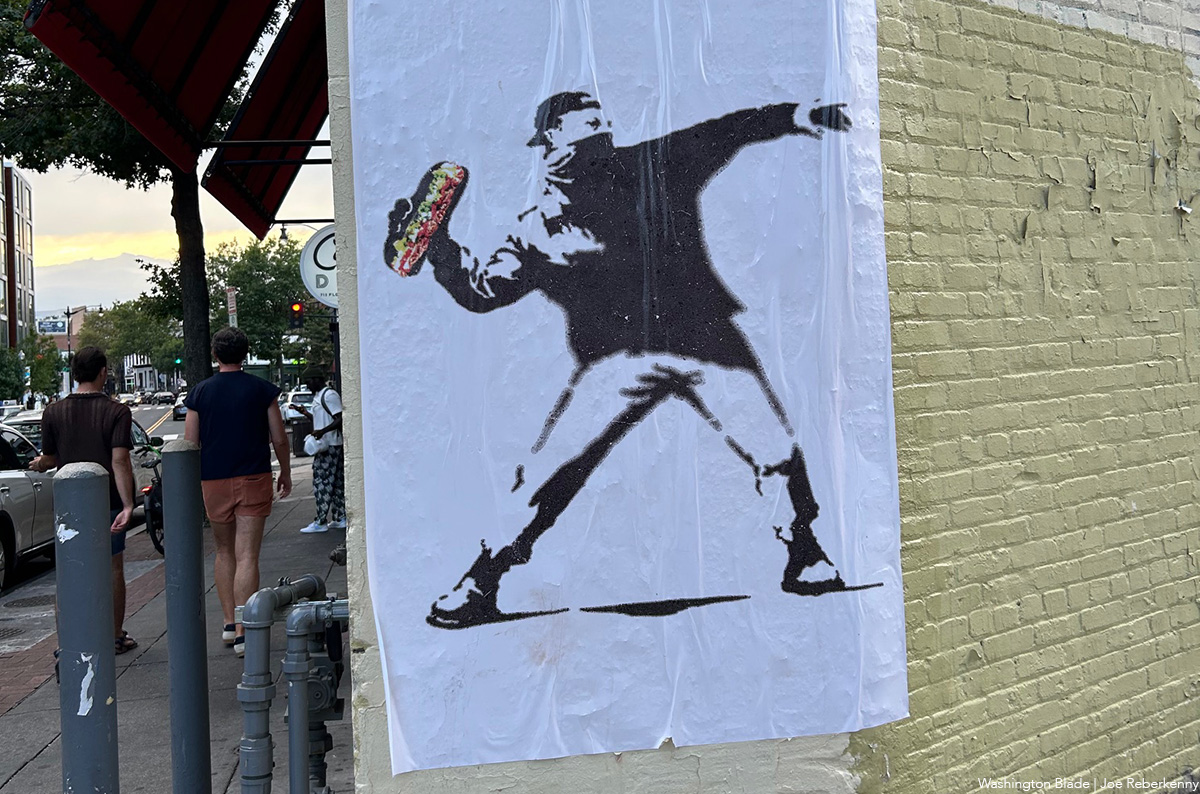
A jury with the U.S. District Court for the District of Columbia on Thursday, Nov. 6, found D.C. resident Sean Charles Dunn not guilty of assault for tossing a hero sandwich into the chest of a U.S. Customs and Border Protection agent at the intersection of 14th and U streets, N.W. at around 11 p.m. on Aug. 10.
Dunn’s attorneys hailed the verdict as a gesture of support for Dunn’s contention that his action, which was captured on video that went viral on social media, was an exercise of his First Amendment right to protest the federal border agent’s participating in President Donald Trump’s deployment of federal troops on D.C. streets.
Friends of Dunn have said that shortly before the sandwich tossing incident took place Dunn had been at the nearby gay nightclub Bunker, which was hosting a Latin dance party called Tropicoqueta. Sabrina Shroff, one of three attorneys representing Dunn at the trial, said during the trial after Dunn left the nightclub he went to the submarine sandwich shop on 14th Street at the corner of U Street, where he saw the border patrol agent and other law enforcement officers standing in front of the shop.
Shroff and others who know Dunn have said he was fearful that the border agent outside the sub shop and immigrant agents might raid the Bunker Latin night event. Bunker’s entrance is on U Street just around the corner from the sub shop where the federal agents were standing.
“I am so happy that justice prevails in spite of everything happening,“ Dunn told reporters outside the courthouse after the verdict while joined by his attorneys. “And that night I believed that I was protecting the rights of immigrants,” he said.
“And let us not forget that the great seal of the United States says, E Pluribus Unum,” he continued. “That means from many, one. Every life matters no matter where you came from, no matter how you got here, no matter how you identify, you have the right to live a life that is free.”
The verdict followed a two-day trial with testimony by just two witnesses, U.S. Customs and Border Protection agent Gregory Lairmore, who identified Dunn as the person who threw the sandwich at his chest, and Metro Transit Police Detective Daina Henry, who told the jury she witnessed Dunn toss the sandwich at Lairmore while shouting obscenities.
Shroff told the jury Dunn was exercising his First Amendment right to protest and that the tossing of the sandwich at Lairmore, who was wearing a bulletproof vest, did not constitute an assault under the federal assault law to which Dunn was charged, among other things, because the federal agent was not injured.
Prosecutors with the Office of the U.S. Attorney for D.C. initially attempted to obtain a grand jury indictment of Dunn on a felony assault charge. But the grand jury refused to hand down an indictment on that charge, court records show. Prosecutors then filed a criminal complaint against Dunn on the misdemeanor charge of assaulting, resisting, or impeding certain officers of the United States.
“Dunn stood within inches of Victim 1,” the criminal complaint states, “pointing his finger in Victim 1’s face, and yelled, Fuck you! You fucking fascists! Why are you here? I don’t want you in my city!”
The complaint continues by stating, “An Instagram video recorded by an observer captured the incident. The video depicts Dunn screaming at V-1 within inches of his face for several seconds before winding his arm back and forcefully throwing a sub-style sandwich at V-1.
Prosecutors repeatedly played the video of the incident for the jurors on video screens in the courtroom.
Dunn, who chose not to testify at his trial, and his attorneys have not disputed the obvious evidence that Dunn threw the sandwich that hit Lairmore in the chest. Lead defense attorney Shroff and co-defense attorneys Julia Gatto and Nicholas Silverman argued that Dunn’s action did not constitute an assault under the legal definition of common law assault in the federal assault statute.
Assistant U.S. Attorney Michael DiLorenzo, the lead prosecutor in the case, strongly disputed that claim, citing various provisions in the law and appeals court rulings that he claimed upheld his and the government’s contention that an “assault” can take place even if a victim is not injured as well as if there was no physical contact between the victim and an alleged assailant, only a threat of physical contact and injury.
The dispute over the intricacies of the assault law and whether Dunn’s action reached the level of an assault under the law dominated the two-day trial, with U.S. District Court Judge Carl J. Nichols, who presided over the trial, weighing in with his own interpretation of the assault statute. Among other things, he said it would be up to the jury to decide whether or not Dunn committed an assault.
Court observers have said in cases like this, a jury could have issued a so-called “nullification” verdict in which they acquit a defendant even though they believe he or she committed the offense in question because they believe the charge is unjust. The other possibility, observers say, is the jury believed the defense was right in claiming a law was not violated.
DiLorenzo and his two co-prosecutors in the case declined to comment in response to requests by reporters following the verdict.
“We really want to thank the jury for having sent back an affirmation that his sentiment is not just tolerated but it is legal, it is welcome,” defense attorney Shroff said in referring to Dunn’s actions. “And we thank them very much for that verdict,” she said.
Dunn thanked his attorneys for providing what he called excellent representation “and for offering all of their services pro bono,” meaning free of charge.
Dunn, an Air Force veteran who later worked as an international affairs specialist at the U.S. Department of Justice, was fired from that job by DOJ officials after his arrest for the sandwich tossing incident.
“I would like to thank family and friends and strangers for all of their support, whether it was emotional, or spiritual, or artistic, or financial,” he told the gathering outside the courthouse. “To the people that opened their hearts and homes to me, I am eternally grateful.”
“As always, we accept a jury’s verdict; that is the system within which we function,” CNN quoted U.S. Attorney for D.C. Jeanine Pirro as saying after the verdict in the Dunn case. “However, law enforcement should never be subjected to assault, no matter how ‘minor,’” Pirro told CNN in a statement.
“Even children know when they are angry, they are not allowed to throw objects at one another,” CNN quoted her as saying.
Maryland
Democrats hold leads in almost every race of Annapolis municipal election
Jared Littmann ahead in mayor’s race.
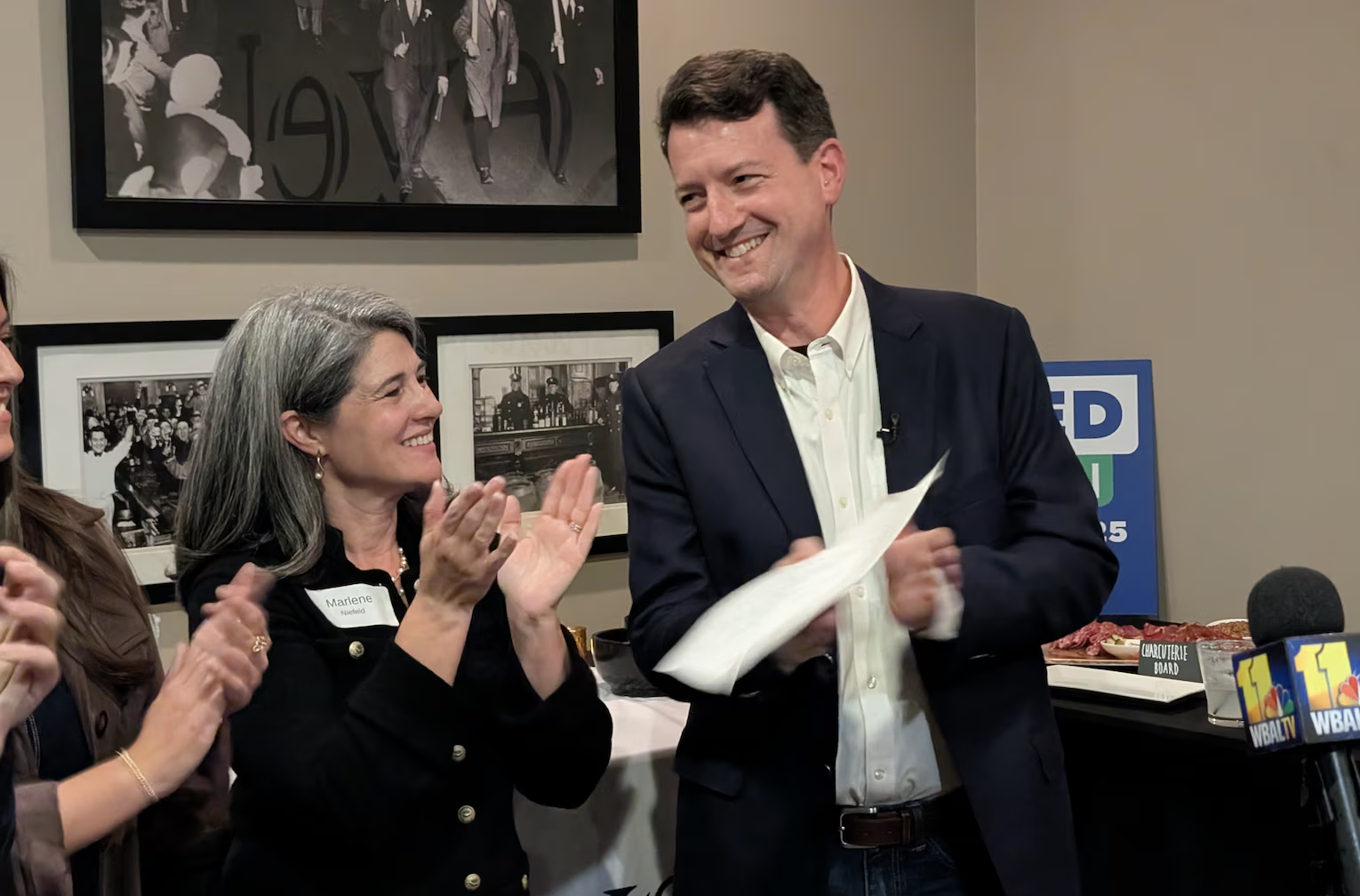
By CODY BOTELER | The Democratic candidates in the Annapolis election held early leads in the races for mayor and nearly every city council seat, according to unofficial results released on election night.
Jared Littmann, a former alderman and the owner of K&B Ace Hardware, did not go so far as to declare victory in his race to be the next mayor of Annapolis, but said he’s optimistic that the mail-in ballots to be counted later this week will support his lead.
Littmannn said November and December will “fly by” as he plans to meet with the city department heads and chiefs to “pepper them with questions.”
The rest of this article can be read on the Baltimore Banner’s website.
-

 U.S. Supreme Court20 hours ago
U.S. Supreme Court20 hours agoSupreme Court rejects Kim Davis’s effort to overturn landmark marriage ruling
-

 District of Columbia5 days ago
District of Columbia5 days ago‘Sandwich guy’ not guilty in assault case
-

 Sports5 days ago
Sports5 days agoGay speedskater racing toward a more inclusive future in sports
-

 Opinions5 days ago
Opinions5 days agoBeginning of the end for Trump
